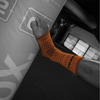
Does Sport Strapping Prevent Injury?
, by Matthew Norton, 5 min reading time

, by Matthew Norton, 5 min reading time
Sprains and strains are the most common sports related injury, effecting millions of people every year. Ankle injuries are the most common, so any way of preventing them is absolutely vital.
Background
Sprains and strains are the most common sports related injury, effecting millions of people every year. Ankle injuries are the most common, so any way of preventing them is absolutely vital.
At Bearhug, we strongly believe in the preventative effects of strapping which is why we are never seen performing sports without our products. In our experience, it has been seen to stop us getting injured as often- but we will use this article to look into the journals and data to see if there is a peer-reviewed study that backs up our preconceptions.
Focus on the Ankle
Most studies that look at sprains and strapping focus on the ankle, as it is by far the most common form of sports injury. Whilst on the surface, sprains seem like a really minor problem, they can cause a pretty serious complication with professional or amateur sports people due to the risk of instability and recurrence.
Taping or a brace placed in direct contact with the skin is thought to improve your muscles ability to make reactive movements based on the current conditions and position (known as proprioceptive acuity) by stimulating parts of the muscle.
A Study of the Physical Effects
In study 4, the scientists examined the effect of ankle taping on joint stability. They user cutting edge technology (standardised stress radio graphs, if you wanted to know!) to measure how the ankle responds at a biological level when it is strapped and unstrapped.
The result was that if an athlete had a condition that caused unstable ankles there was a noticeable effect in the reaction time of the muscles. If you taped this muscle, then it would bring the reaction time down, although it would not bring it quite back to the level that was recorded in the uninjured ankles.
The study wasn’t able to use the testing methods to prove if the strapping has a significant effect on uninjured ankles- however the results are promising!
How about in Basketball?
Basketball is a sport that is amazingly demanding on the ankles, as there is a lot of swift changes of direction and flexing motions involved with the standard movements. Because of this there is a huge risk of injury of the ankle, this makes it perfect for studies!
Whilst the design of the strapping used in study 5 is different to the Bearhug support, the lace up they used offers compression in a similar way to our ankle supports. In the study, a large number of players (1460 male and female basketball players from 46 high schools) were randomly chosen to wear a brace, or carry on as normal without one.
The braced group players wore lace-up ankle braces during the 2009-2010 basketball season. Coaches and teachers recorded injuries and a bunch of other metrics that aren’t as important for the results. A few data models were put in place and the Injury severity (days lost) was tested and ranked. The results were pretty amazing; the use of lace-up ankle braces reduced the incidence but not the severity of ankle injuries in people with and without a previous history of an ankle injury.
That is great news! Whilst evidence of decreased severity might be a bit of a holy grail for us ankle strappers, but at least we have evidence that being strapped helps with prevention!
A deeper delve
A commonly used term in journals for Bearhug type supports is PAS or Prophylactic Ankle Stabilisers, this is a catch all term for external ankle supports that are used in place of strapping.
To date, 4 studies have been completed to try to work out how effective these Bearhug type of supports are to athletes in relation to injury prevention. The great news is that the general consensus is that they are effective in reducing the incidence of acute ankle sprains.
M.R Sitler in the Journal of Sports Medicine is quoted as saying:
“The use of PAS for ankle injury reduction appears to be justified although further research is required.”
In Conclusion
It appears as though there is good evidence for strapping not only helping when athletes are injured, but they do seem to have a positive effect in prevention. Whilst there may be years more studying to be done, after putting this article together we are even more confident in wearing our Bearhug Supports!